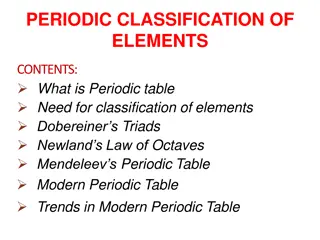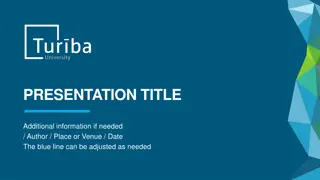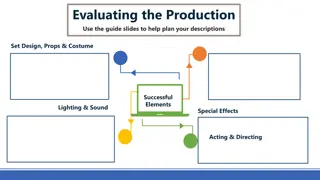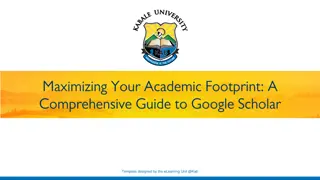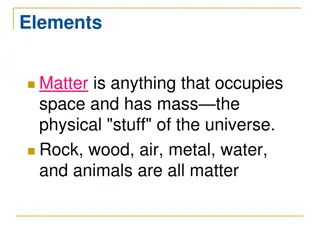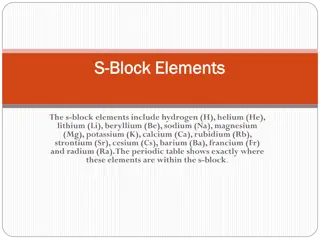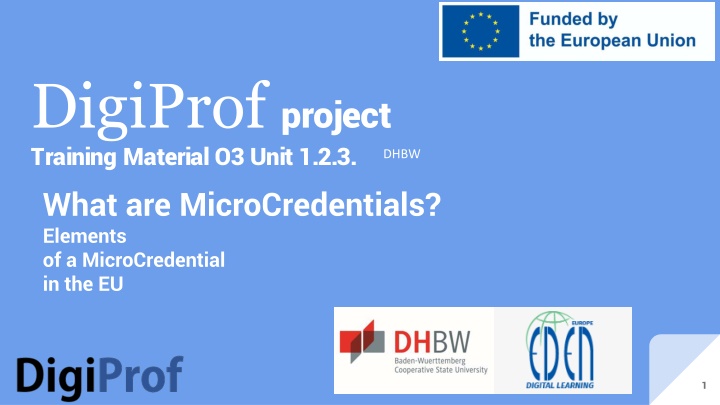
MicroCredentials in the European Union
Explore the concept of MicroCredentials in the EU, including elements, mandatory and optional components, and the European data model. Learn about the guidelines for awarding, assessment, and quality assurance of MicroCredentials for lifelong learning and employability.
Download Presentation

Please find below an Image/Link to download the presentation.
The content on the website is provided AS IS for your information and personal use only. It may not be sold, licensed, or shared on other websites without obtaining consent from the author. If you encounter any issues during the download, it is possible that the publisher has removed the file from their server.
You are allowed to download the files provided on this website for personal or commercial use, subject to the condition that they are used lawfully. All files are the property of their respective owners.
The content on the website is provided AS IS for your information and personal use only. It may not be sold, licensed, or shared on other websites without obtaining consent from the author.
E N D
Presentation Transcript
DigiProf project Training Material O3 Unit 1.2.3. What are MicroCredentials? Elements of a MicroCredential in the EU DHBW 1
1. Identification of the learner 1. Title of the micro-credential 1. Country(ies)/Region(s) of the issuer Mandatory Elements of a MC 1. Awarding body(ies) 1. Date of issuing 1. Learning outcomes from Annex 1, Proposal for a Council Recommendation on a European approach to micro-credentials for lifelong learning and employability -Adoption , May 2022 1. Notional workload needed to achieve the learning outcomes (in ECTS credits, where possible) https://data.consilium.europa.eu/doc/document/ST- 9237-2022-INIT/en/pdf 2 2022 DHBW
8. Level (and cycle, if applicable) of the learning experience leading to the micro-credential (EQF, QF-EHEA), if applicable Mandatory Elements of a MC 8. Type of assessment 8. Form of participation in the learning activity from Annex 1, Proposal for a Council Recommendation on a European approach to micro-credentials for lifelong learning and employability -Adoption , May 2022 8. Type of quality assurance used to underpin the micro-credential https://data.consilium.europa.eu/doc/document/ST- 9237-2022-INIT/en/pdf 3 2022 DHBW
1. Prerequisites needed to enrol in the learning activity 1. Supervision and identity verification during assessment Optional Elements of a MC 1. Grade achieved 1. Integration/stackability options (stand- alone, independent microcredential/integrated, stackable towards another credential) from Annex 1, Proposal for a Council Recommendation on a European approach to micro-credentials for lifelong learning and employability -Adoption , May 2022 https://data.consilium.europa.eu/doc/document/ST-9237- 2022-INIT/en/pdf 1. Further information 4 2022 DHBW
The 11 mandatory and various optional elements are included in a European data model (EDCI): Data integration specification of a common format for describing micro-credentials available as an open standard to be used by providers of micro-credential supporting interoperability and facilitating exchange of data on micro-credentials https://ec.europa.eu/futurium/en/system/files/ged/edc i_presentation.pdf https://github.com/european-commission- empl/European-Learning-Model 5 2022 DHBW
Comments or Questions? Please contact us for further ideas, questions or remarks on this training material ursula.goez@heilbronn.dhbw.de Training material "Ensuring digital and micro-credentialization of learning as a part of transparent assessment for recognition of learning outcomes" by G z U., Cepauskiene R., is licensed under a Creative Commons Attribution- ShareAlike 4.0 International License 6 2022 DHBW





